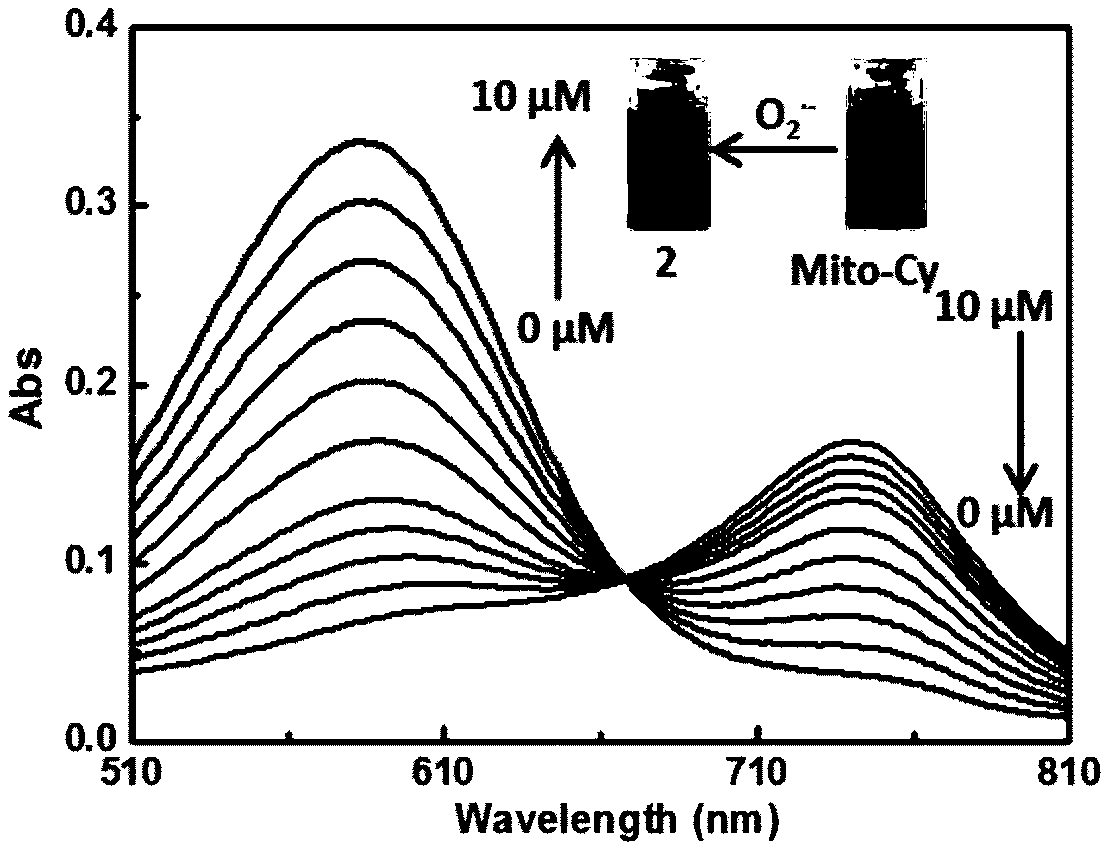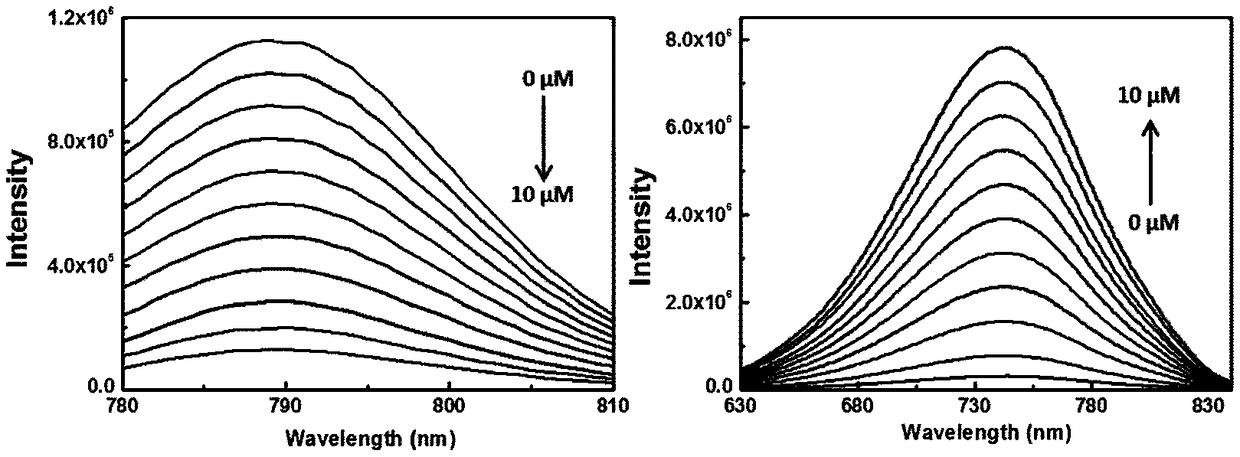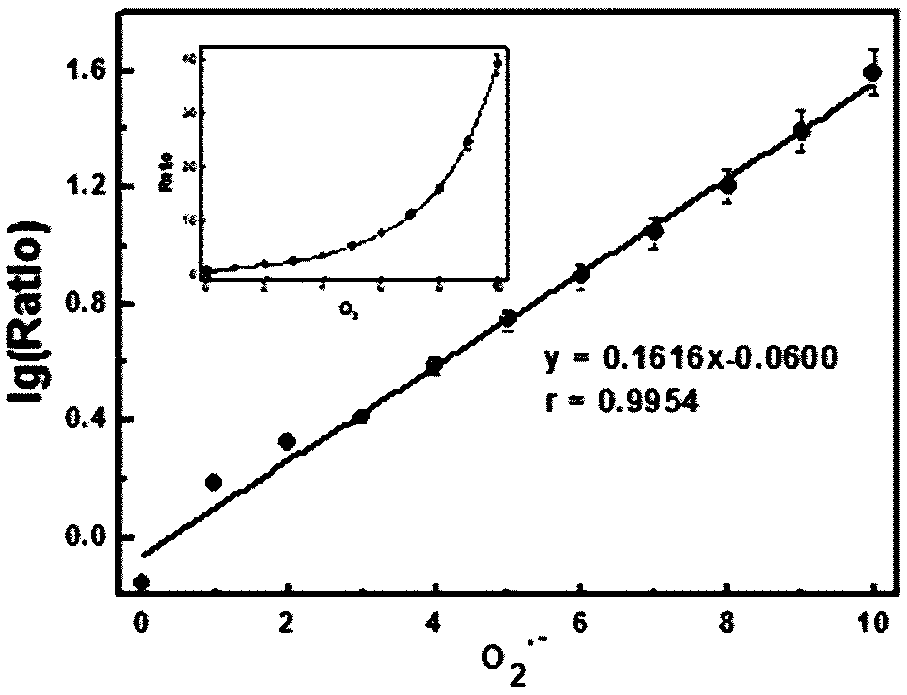A kind of organic compound and application thereof based on cyanine
A technology of organic compounds and free radicals, applied in the field of near-infrared fluorescent probes, can solve problems such as damage to biological samples, slow response, inability to effectively avoid biological autofluorescence interference, etc., to reduce interference and improve detection accuracy.
- Summary
- Abstract
- Description
- Claims
- Application Information
AI Technical Summary
Problems solved by technology
Method used
Image
Examples
Embodiment 1
[0031] The structural formula of cyanine-based organic compounds is:
[0032]
[0033] The compound of formula I and the O in the water body to be determined, the simulated physiological environment or the organism 2 ·- Combining, the compound of structural formula II structure is obtained, which leads to the change of the fluorescence intensity and wavelength of the compound of formula I, and the change of ultraviolet absorption, and then utilizes the compound of formula I in O 2 ·- The compound of formula II can be formed under O 2 ·- Perform qualitative and quantitative testing.
[0034]
[0035] Preparation of organic compound of formula I based on cyanine:
[0036] (1) Preparation of Compound 1
[0037] Under nitrogen protection, (4-bromobutyl)triphenylphosphine bromide (14.35g, 30mmol) and sodium azide (3.9g, 60mmol) were dissolved in 50mL DMF. Stir overnight at 90°C. The color of the solution ranges from colorless to light yellow to red. The reaction flas...
Embodiment 2
[0049] The compound shown in the prepared formula I is used as a probe in water system, simulated physiological environment and intracellular for O 2 ·- The detection of simulating physiological conditions, the following experiments were all carried out under the condition of pH=7.4 (HEPES buffer solution, the concentration was 40mM), and the probe concentration was 10μM.
[0050] The compound shown in the above-mentioned preparation gained formula I to O 2 ·- UV response of:
[0051] pH was controlled with HEPES buffer solution. Add 10μM formula I compound to each 10mL colorimetric tube, then add 40mM HEPES with different pH, and then add 10μM O 2 ·- , dilute to 10ml with ultrapure water, shake the solution evenly, and after equilibrating for 10 minutes, add the above-mentioned working solution into a cuvette to measure the ultraviolet absorption spectrum. The UV absorption spectrum was used to detect O 2 ·- before and after changes such as figure 1 As shown, the com...
Embodiment 3
[0054] The compound shown in formula I is pair O 2 ·- Fluorescent response of:
[0055] pH was controlled with HEPES buffer solution. Add 10μM compound formula 1 to each 10ml colorimetric tube, then add 40mM HEPES of different pH, and then add 10μM O 2 ·- , dilute to 10ml with ultrapure water, shake the solution evenly, and after equilibrating for 10 minutes, add the above working solution into a fluorescent dish to measure the fluorescence spectrum. Fluorescence spectroscopy in the detection of O 2 - before and after changes such as figure 2 shown. The compound shown in formula I can be used to realize O in vivo 2 - detection.
[0056] Depend on figure 2 means with O 2 ·- The change of the fluorescence intensity of the system with the change of concentration indicates that with the change of O 2 - With the increase of the concentration, the fluorescence intensity in the 630-830nm band of the system is obviously enhanced, and the fluorescence intensity in the ...
PUM
 Login to View More
Login to View More Abstract
Description
Claims
Application Information
 Login to View More
Login to View More - R&D
- Intellectual Property
- Life Sciences
- Materials
- Tech Scout
- Unparalleled Data Quality
- Higher Quality Content
- 60% Fewer Hallucinations
Browse by: Latest US Patents, China's latest patents, Technical Efficacy Thesaurus, Application Domain, Technology Topic, Popular Technical Reports.
© 2025 PatSnap. All rights reserved.Legal|Privacy policy|Modern Slavery Act Transparency Statement|Sitemap|About US| Contact US: help@patsnap.com



